Policy changes and "spending restraints" in some of the federal government's key health programs will contribute to a decline in its spending as a proportion of GDP over the next decade, according to a new report from the Parliamentary Budget Office (PBO).
The independent PBO provides analysis on the budget and government fiscal policy.
According to its latest report, which provides an annual update on the federal government's budget projections for 23 major programs over the next decade, restraints in payments through Medicare, the Pharmaceutical Benefits Scheme and a range of other programs will offset the rapid growth in spending on the NDIS.
It says, "...the largest contributor to the growth in spending over the next decade is spending on the NDIS, which is projected to increase as a share of GDP by 0.4 per cent. The next largest contributor to growth is defence spending (projected to increase by 0.3 per cent of GDP), followed by spending on aged care (projected to increase by 0.2 per cent of GDP) and spending on the Medicare Benefits Schedule (projected to increase by 0.1 per cent of GDP)."
Payments through the NDIS are expected to rise from $11 billion in 2018-19 to $32 billion in 2029-30.
Spending on the Private Health Insurance Rebate is expected to rise over the same period, from $6 billion to $9 billion, but it will remain unchanged as a proportion of GDP at 0.3 per cent.
"Expenditure on PHI is projected to grow in line with the population and CPI, with the insurance coverage ratio assumed to be unchanged through the medium-term at the estimated 2022–23 level," says the report.
"Growth in Medicare services in recent years has been driven by increased usage, particularly by people aged 65 and over. Medicare payments are projected to experience price growth over the medium term as the freeze on indexation is lifted on more Medicare items in 2019 and 2020," says the report.
Spending on Medicare will rise as a proportion of GDP, from 1.3 to 1.4 per cent, or from $24 billion to $45 billion.
Spending on public hospitals will also rise, from $22 billion to $38 billion, and as a proportion of GDP from 1.1 to 1.2 per cent.
For the PBS, spending will rise from $12 billion to $16 billion, but as a proportion of GDP it will fall from 0.7 to 0.5 per cent.
